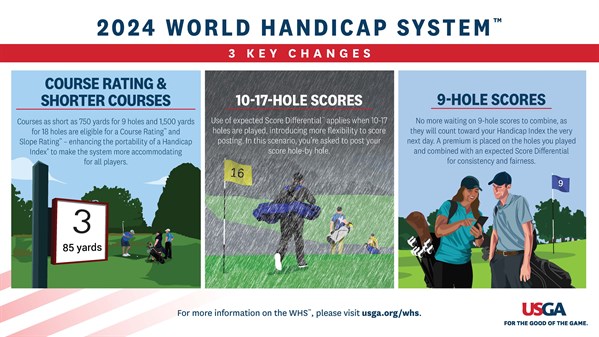The WORLD HANDICAP SYSTEM™ enables golfers of different abilities to play and compete on a fair basis, in any format, on any course, anywhere around the world. WHS unified six different handicap systems that were in use around the world into a single system.
November 8, 2023 - The USGA and The R&A announced the first update to the World Handicap System™ as part of an ongoing review of the Rules of Handicapping™ and Course Rating System™ with a conitnued emphasis on accuracy, consistency and equity. The latest revisions will go into effect beginning January 1, 2024.
Many countries have seen significant increases in the number of scores being submitted for handicapping purposes since the WHS™ was introduced in January 2020, reflecting golf's broadening appeal. More than 100 million score have been posted each year, unifying millions of golfers through a standard measure of playing ability. The 2024 update leverages the performance data gathered from around the world, in addition to feedback received from many of the 125 countries now using the system.
Significant updates to the WHS™ include:
- Inclusion of Shorter-Length Golf Course Within the Course Rating System™: The overall length requirements for Course Rating in the WHS will be significantly reducted. A set of tees on a 18-hole course may be as short as 1,500 yards to be eligible for a Course Rating and Slope Rating, and a set of tees on a 9-hole course may be as short as 750 yards. This change is intended to expand the WHS to thousands of shorter length courses, including par-3 courses, and enable more golfers to obtain and use a Handicap Index.
- Use of an Expected Score for a Hole Not Played: Improvements have been made to the method used to handle holes not played, which will now be based on a player's expected score rather than a score of net par. This method will produce a 9-hole or 18-hole Score Differential that more than accurately reflects a player's ability. As golfers across the world are playing more 9-hole rounds, an expected score can also be used to convert a 9-hole round into an 18-hole Score Differential. For some countries, this means that 9-hole scores will be considered in the calculation of a player's Handicap Index immediately after the day of play, rather than waiting to combine with another 9-hole score.
- Playing Conditions Calculation Adjustmnts Made More Frequent: The Playing Conditions Calculation (PCC) has been modified to increase the likelihood of an adjustment for abnormal playing conditions. National associations were given discretion, beginning in July 2022, to introduce this revision within their computation platforms, which will be complete by April 1. 2024.
- Enhanced Guidance on Conducting a Handicap Review: The Role of the Handicap Committee is vital to the success of the WHS and the Rules recommend that a Handicap Review is conducted regularly, or atleast once a year to ensure a Handiacp Index remains reflective of a player's ability. New reporting tools have been developed that national associations can incorporate into their handicapping software to assist Committees in conducting the review process effectively and consistently.

Frequently Asked Questions
World Handicap System Education for Golfers
- Three Key Changes
- Change Summaries for the 2024 Revision to the WHS
- The Rules of Handicapping, effective January 2024
- Player Reference Guide on the Rules of Handicapping, effective January 2024
